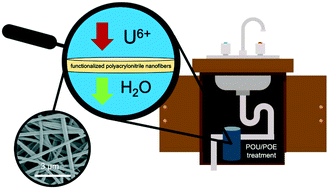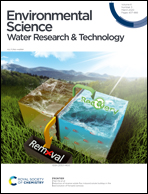Functionalized electrospun polymer nanofibers for treatment of water contaminated with uranium†
Abstract
Uranium (U) contamination of drinking water often affects communities with limited resources, presenting unique technology challenges for U6+ treatment. Here, we develop a suite of chemically functionalized polymer (polyacrylonitrile; PAN) nanofibers for low pressure reactive filtration applications for U6+ removal. Binding agents with either nitrogen-containing or phosphorous-based (e.g., phosphonic acid) functionalities were blended (at 1–3 wt%) into PAN sol gels used for electrospinning, yielding functionalized nanofiber mats. For comparison, we also functionalized PAN nanofibers with amidoxime (AO) moieties, a group well-recognized for its specificity in U6+ uptake. For optimal N-based (Aliquat® 336 or Aq) and P-containing [hexadecylphosphonic acid (HPDA) and bis(2-ethylhexyl)phosphate (HDEHP)] binding agents, we then explored their use for U6+ removal across a range of pH values (pH 2–7), U6+ concentrations (up to 10 μM), and in flow through systems simulating point of use (POU) water treatment. As expected from the use of quaternary ammonium groups in ion exchange, Aq-containing materials appear to sequester U6+ by electrostatic interactions; while uptake by these materials is limited, it is greatest at circumneutral pH where positively charged N groups bind negatively charged U6+ complexes. In contrast, HDPA and HDEHP perform best at acidic pH representative of mine drainage, where surface complexation of the uranyl cation likely drives uptake. Complexation by AO exhibited the best performance across all pH values, although U6+ uptake via surface precipitation may also occur near circumneutral pH values and at high (10 μM) dissolved U6+ concentrations. In simulated POU treatment studies using a dead-end filtration system, we observed U removal in AO-PAN systems that is insensitive to common co-solutes in groundwater (e.g., hardness and alkalinity). While more research is needed, our results suggest that only 80 g (about 0.2 lbs.) of AO-PAN filter material would be needed to treat an individual's water supply (contaminated at ten-times the U.S. EPA maximum contaminant level for U) for one year.



 Please wait while we load your content...
Please wait while we load your content...
